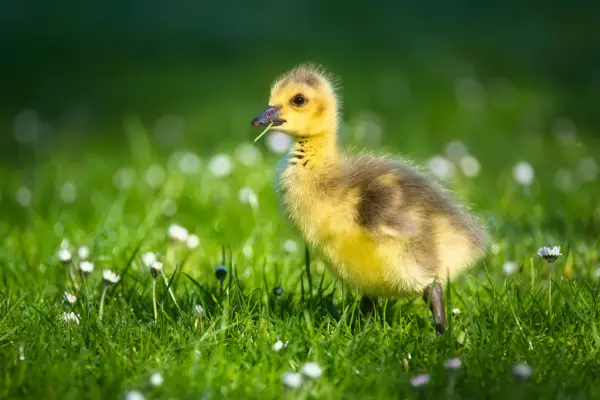Mexico, celebrated for its breathtaking beaches, vibrant culture, and ancient ruins, reveals another dimension of its allure – a diverse tapestry of bird species. The Mexican avian panorama encompasses a remarkable 1040 species, with 125 exclusive to this region, a testament to the country’s unique geographical tapestry that includes cloud forests, savannas, deserts, mangroves, mountains, and coastlines.
Embark on a journey as we spotlight a curated selection of Mexico’s avian wonders, from the ocean-roaming Magnificent Frigatebird to the delicate Broad-billed Hummingbird. Let’s unravel their distinctive features, preferred habitats, dietary habits, and geographical distributions.
1. Great-tailed Grackle (Quiscalus mexicanus)
The Great-tailed Grackle, a captivating black bird native to Mexico, dons glossy black plumage with a purple gloss for males and a more subdued appearance for females. With dark brown upperparts, pale underparts, and distinct yellow eyes, these adaptable birds thrive in urban areas, parks, yards, golf courses, agricultural fields, chaparral, and marshes.
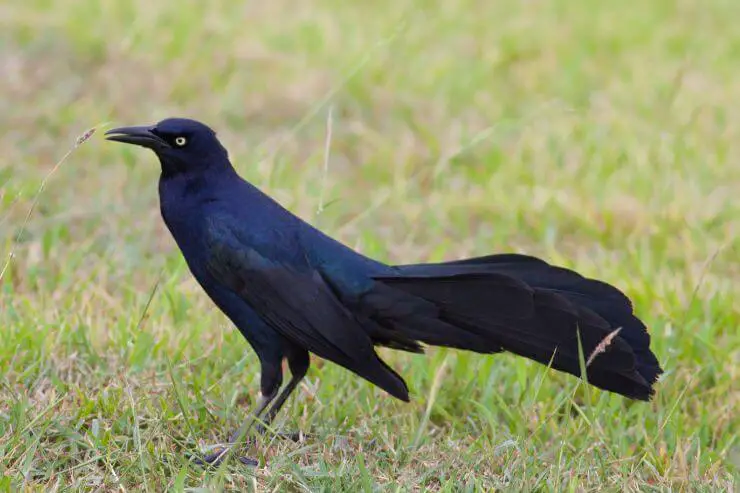
Omnivorous in nature, their diverse diet includes fruits, seeds, grains, insects, spiders, worms, snails, frogs, reptiles, fish, bird nestlings, eggs, and small mammals. The Great-tailed Grackle’s reach extends from the southern United States to northern South America.
2. Canyon Towhee (Melozone fusca)
The Canyon Towhee, a substantial sparrow with brown plumage and distinctive markings, calls Mexico and parts of the southwestern United States home. Flourishing in arid and semi-arid locales like desert canyons, rocky slopes, and dry grasslands, these birds sustain themselves on seeds, berries, insects, spiders, snails, and millipedes.

3. Great Kiskadee (Pitangus sulphuratus)
A vibrant yellow spectacle in Mexican landscapes, the Great Kiskadee boasts a yellow underside, black-and-white striped head, and a bright yellow crown. Inhabiting woodlands, savannas, scrublands, thickets, and urban areas near water, these versatile birds exhibit opportunistic feeding habits, consuming insects, frogs, small lizards, nestlings, small mammals, fruit, and fish.
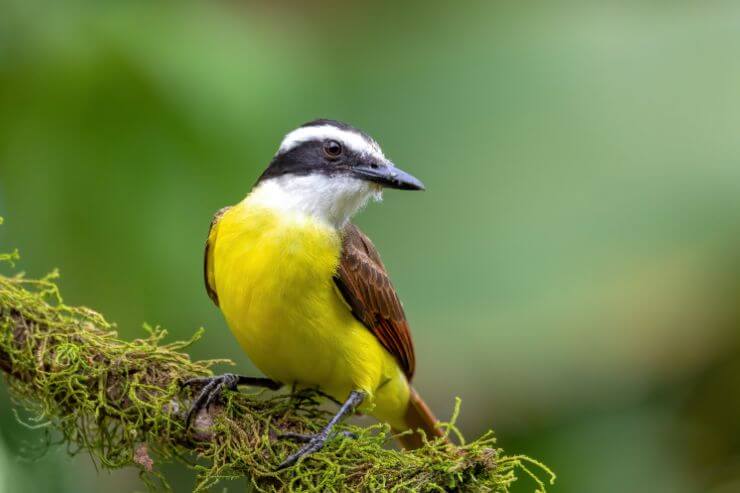
4. Magnificent Frigatebird (Fregata magnificens)
The Magnificent Frigatebird, a majestic seabird with an impressive wingspan, dominates tropical oceans and coastlines throughout the Americas. Males showcase glossy black plumage, a forked tail, and a distinctive red throat pouch for courtship displays, while females exhibit white chests, a pale brown wing bar, and a gray throat pouch.
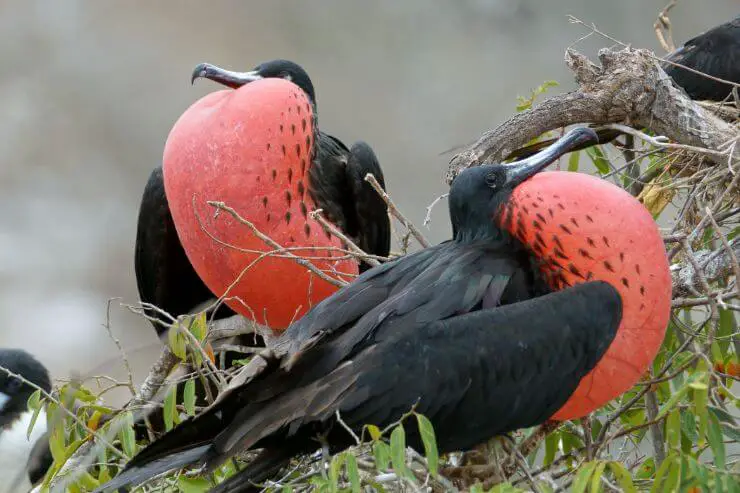
Thriving along the Pacific and Atlantic coasts of the southern United States, Mexico, Central America, and South America, these adept fishermen specialize in feeding on fish and squid, displaying their adaptability to a life at sea. Additionally, their diet encompasses crabs, plankton, jellyfish, juvenile turtles, bird eggs, and nestlings.
5. Black Vulture (Coragyps atratus)
The Black Vulture, a formidable bird of prey, showcases a predominantly black plumage with a subtle gloss and a distinctive bald, wrinkly, grayish-black head. Flourishing in diverse habitats like open woodlands, grasslands, and urban areas, these birds are often observed soaring, utilizing their sharp eyesight to locate carrion, their primary food source.

In addition to carrion, the Black Vulture’s diet encompasses insects, fish, reptiles, nestlings, bird eggs, and plant matter, showcasing their adaptability. Their broad distribution spans from the southern and southeastern United States to South America.
6. Mexican Jay (Aphelocoma wollweberi)
The Mexican Jay, a captivating long-tailed blue songbird native to Mexico, boasts primarily blue upperparts with a gray back patch and grayish underparts. Inhabiting pine-oak forests, woodlands, and desert grasslands with oak-lined streams, these charismatic birds exhibit a striking plumage.

Feeding on nuts, acorns, berries, insects, lizards, snakes, small mammals, frogs, nestlings, and bird eggs, the Mexican Jay’s dietary preferences contribute to its ecological significance. While their primary range is in Mexico, a fraction extends into the southern United States.
7. Great Egret (Ardea alba)
The Great Egret, an elegant and tall bird with white plumage, a long neck, and a dagger-like yellow bill, captures attention. During the breeding season, their aesthetic appeal is enhanced by long plumes, green facial skin, and a black bill in most regions except the Americas.
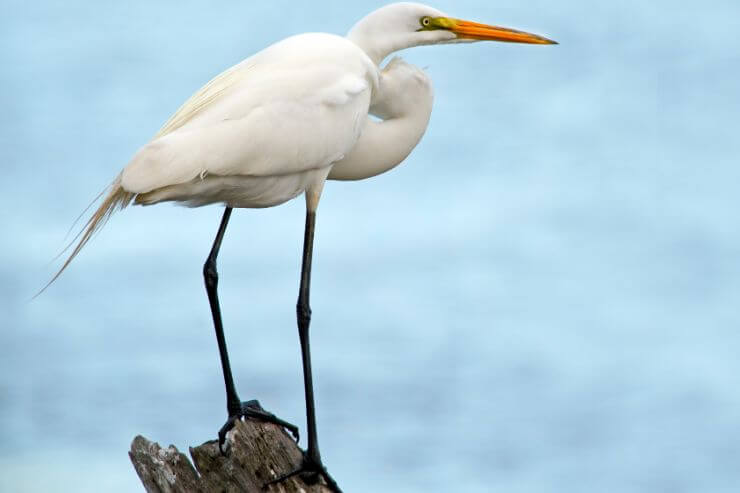
Widely distributed on every continent except Antarctica, the Great Egret is a partially migratory species. Their habitats include wetlands, marshes, estuaries, ponds, rivers, swamps, lakes, mangroves, and flooded fields. Wading in shallow water, they patiently wait for aquatic prey and consume a diet comprising frogs, small mammals, crustaceans, reptiles, birds, and insects.
8. Golden Eagle (Aquila chrysaetos)
The Golden Eagle, among the largest birds in Mexico, commands attention with its majestic presence, featuring dark brown plumage, a golden-brown nape, pale flight feathers, a sizable blue-gray beak, and striking golden-yellow eyes. Thriving in mountainous and open habitats with sparse vegetation, these birds of prey exhibit impressive size and strength.

With a wide distribution across North America, Europe, Asia, and parts of northern Africa, the Golden Eagle is a formidable hunter. Their diet primarily consists of small to medium-sized mammals, occasionally extending to birds, seals, fish, and carrion. This magnificent species plays a vital role in maintaining ecological balance in its diverse habitats.
9. Broad-billed Hummingbird (Cynanthus latirostris)
The captivating Broad-billed Hummingbird, renowned for its vibrant plumage and aerial prowess, stands out as a small marvel. The male features bright green upper and underparts, a blue throat, a dark upper tail, a white undertail, and an elongated, straight, red bill.
Females, with a more understated appearance, display a pale green back, a grayish underside, a white eye stripe, and a subdued white throat.
These hummingbirds thrive in canyons, riparian woodlands, and thorn forests.
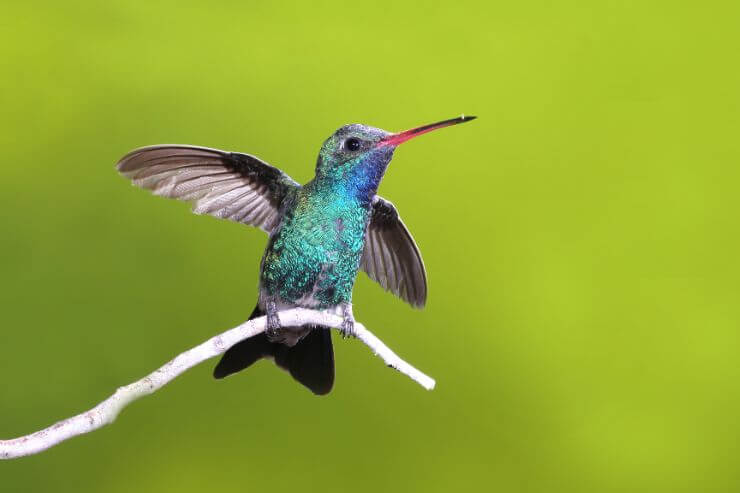
True to their hummingbird nature, they primarily subsist on nectar, adeptly hovering as they sip from flowers with their extended tongues. Additionally, they include insects in their diet. While predominantly found in Mexico, they extend their range into the southwestern United States. Most are residents, but northern counterparts embark on a migratory journey from the United States and northern Mexico to the southern expanses of Mexico.
10. Golden-fronted Woodpecker (Melanerpes aurifrons)
The Golden-fronted Woodpecker, a medium-sized species, dons a buffy-brown ensemble, adorned with black and white barring on the upper side, a white rump, and a black tail. Distinctive features include a golden-yellow forehead, a red crown, and a golden-orange nape.
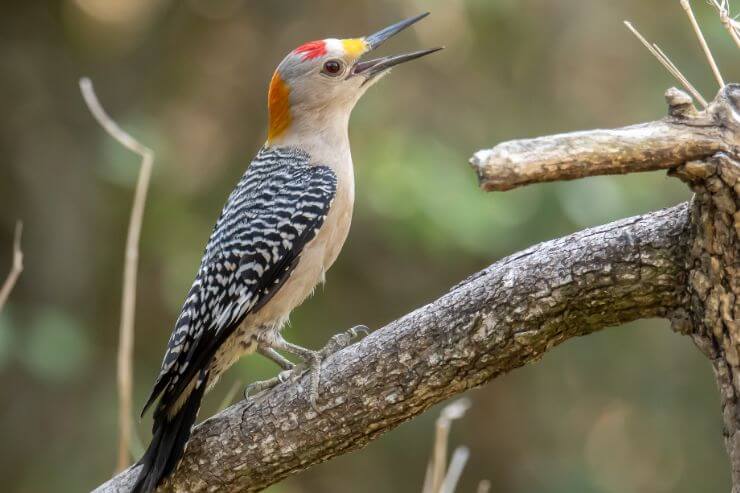
While females share a similar color palette, they exhibit a more subdued version. These woodpeckers inhabit open woodlands, forests, arid scrublands, parks, and yards, showcasing characteristic behavior by hopping up and down tree trunks, and foraging for hidden insects and larvae beneath the bark.
Their diet comprises a medley of insects, spiders, fruit, seeds, and nuts. Geographically, this species covers vast expanses, ranging from most of Mexico and northern Central America to parts of the southern United States.
11. Bewick’s Wren (Thryomanes bewickii)
Bewick’s Wren, a slender and diminutive wren species, showcases a brown upperside, a pale gray underside, a white throat, a long barred tail, a white eyebrow stripe, and a slender, gracefully curved beak.
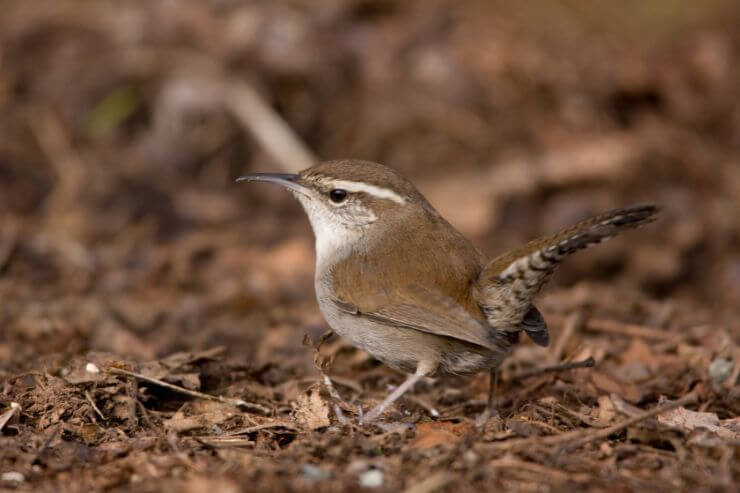
These wrens find their habitat in shrublands, chaparral, thickets, forests, woodlands, parks, and yards. Their diet encompasses insects, spiders, seeds, and fruit. Geographically, Bewick’s Wren boasts an extensive distribution, spanning from far southwestern Canada to southern Mexico.
12. Vermilion Flycatcher (Pyrocephalus rubinus)
The enchanting Vermilion Flycatcher, a petite red-hued bird, graces the southwestern United States, Mexico, Central America, and South America. The male, adorned with a bright red crown and underside, boasts a brown back, black wings and tail, and a brown face mask.
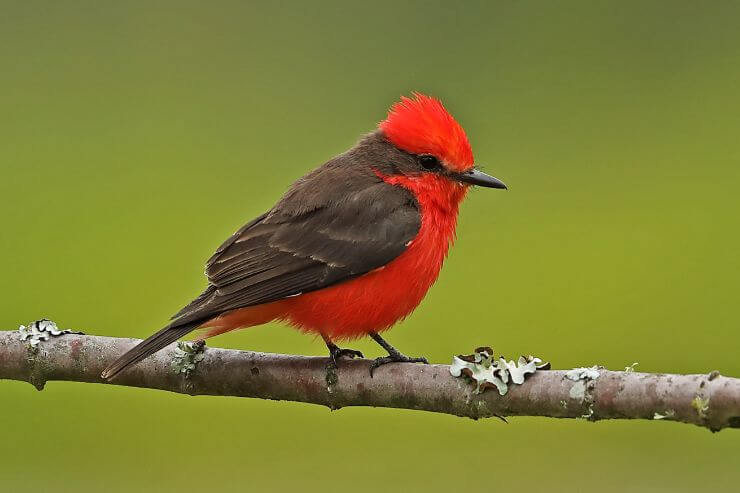
Females, with their grayish-brown upperside, whitish underside streaked with red, exemplify a more subtle elegance. Thriving in open habitats like deserts, scrublands, open woodlands, agricultural lands, and fields, these flycatchers are often spotted perched on branches or utility wires, darting forth to capture insects.
Vermilion Flycatchers exhibit diverse migration patterns. Those summering in the United States migrate to Mexico for winter, while birds in Mexico, Central America, and northern South America are residents. Meanwhile, those from southern South America migrate north for the Austral winter.
13. Inca Dove (Columbina inca)
The diminutive Inca Dove, sporting sandy-gray plumage adorned with intricate scalloped patterns, captures attention. Noteworthy features include white outer tail feathers and chestnut underwings.

Inca Doves thrive in diverse environments, including desert scrublands, farmlands, parks, and yards. Their dietary preferences center around seeds and grains. Geographically, this species is distributed across the southwestern United States, Mexico, and Central America.
Conclusion
While this exploration has only scratched the surface of Mexico’s avian diversity, it underscores the country’s status as a haven for birdwatchers. From the captivating Broad-billed Hummingbird to the elegant Vermilion Flycatcher, each bird contributes to the vibrant tapestry of Mexico’s ecological landscape with its unique characteristics, habitat preferences, dietary habits, and distribution patterns.




